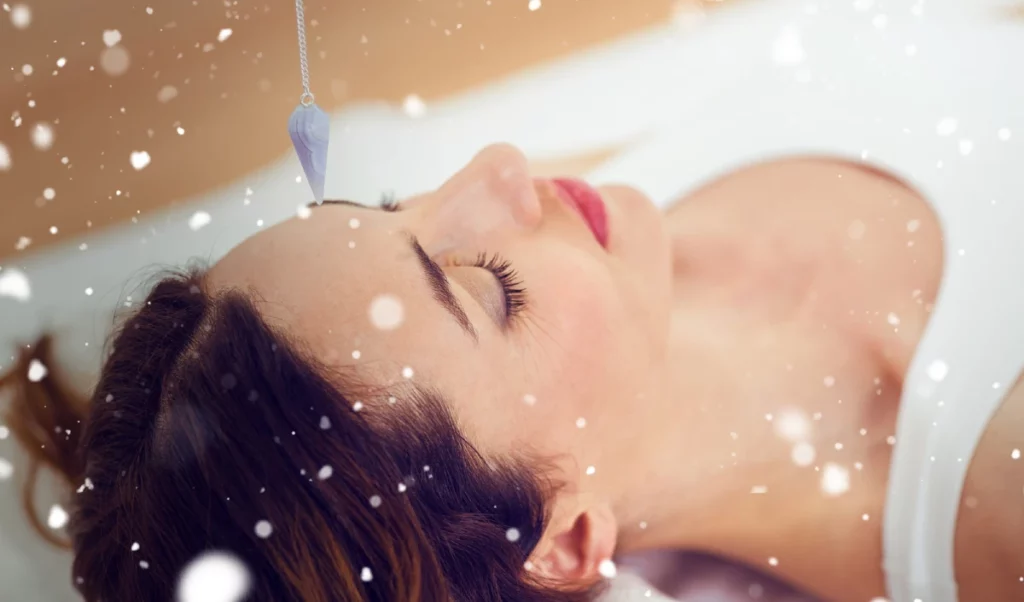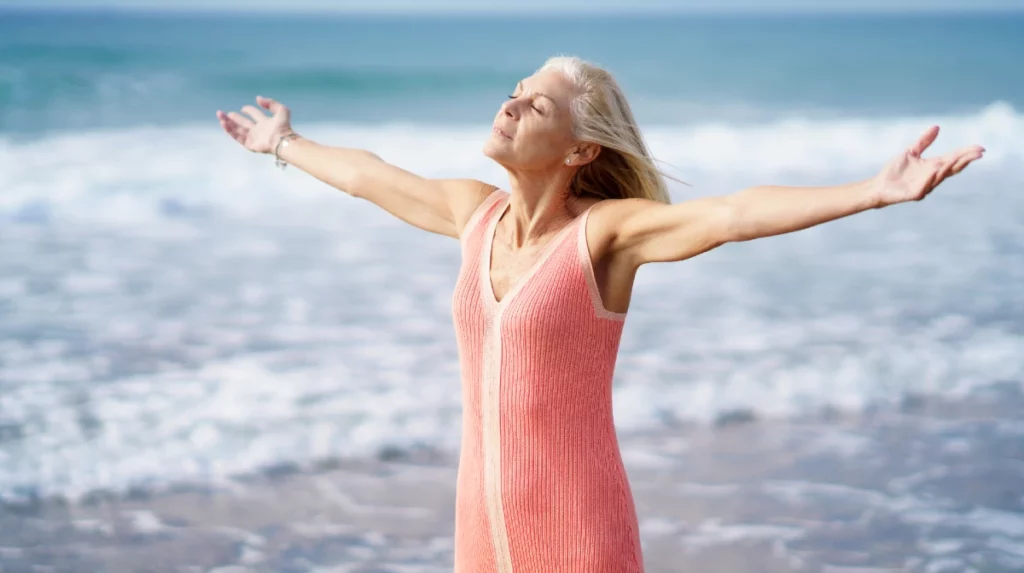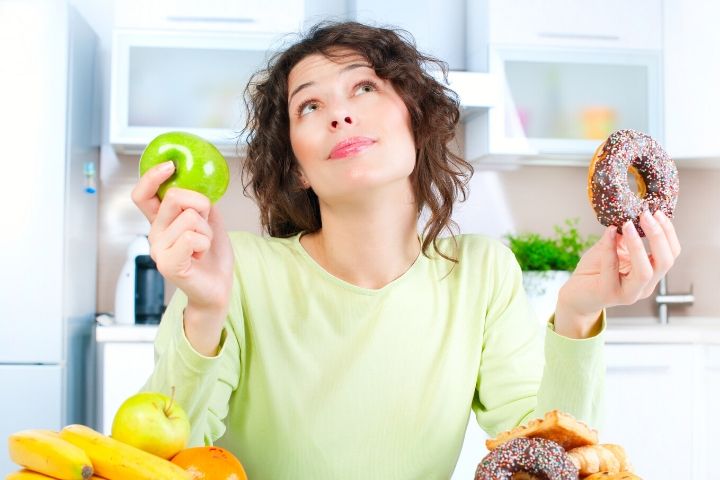How to use guided imagery for menopause and perimenopause?
- 0 comments
- by Loren
Did you know that you can use guided imagery during menopause and perimenopause to alleviate your symptoms and to be happier? Guided imagery can help us relax, promote healing, and manage stress and anxiety which are very common and very painful during this time. Furthermore, stress and anxiety are the causes of other menopause symptoms.

Stress, as I keep repeating in my articles and to my clients, is one of our biggest enemies during menopause and perimenopause. Stress causes hormonal imbalances and cellular inflammation. Stress is detrimental at any time, but during perimenopause and menopause when our hormones are already in disarray, stress is even more damaging.
In addition to lowering stress, guided imagery is also wonderful to heal trauma, to overcome doubt and to discover ourselves, to get in touch with our inner child, and it can help us grow and be the best version of ourselves. These are also important emotional aspects during menopause and perimenopause and they also have an effect on symptoms like hot flashes, insomnia, fatigue, memory fog, and others.
What is guided imagery?
Guided imagery is a mind-body technique that has many therapeutic effects. Guided imagery normally uses your imagination to talk to your subconscious and communicate messages that will promote healing.
Guided imagery has many uses including relaxation, personal growth, trauma healing, to overcome fears, and to heal physical and emotional illnesses. It is widely used in professional sports to reach higher performance levels and in psychology.
Guided imagery involves using your imagination to visualize vivid scenarios in your mind. It is like running a movie in your mind or virtual reality in your mind. As the name indicates, it is guided by a script. Just like movies need a story, guided imagery also needs a story or script.
Following is the Wikipedia definition of guided imagery. Let me tell you it’s a mouthful; they didn’t make it easy for everybody to understand, but I already paraphrased it above for you. “Guided imagery (also known as guided affective imagery, or katathym-imaginative psychotherapy) is a mind-body intervention by which a trained practitioner or teacher helps a participant or patient to evoke and generate mental images that simulate or recreate the sensory perception of sights, sounds, tastes, smells, movements, and images associated with touch, such as texture, temperature, and pressure, as well as imaginative or mental content that the participant or patient experiences as defying conventional sensory categories, and that may precipitate strong emotions or feelings in the absence of the stimuli to which correlating sensory receptors are receptive.”

Why guided imagery in menopause and perimenopause?
We kind of covered this above, but let’s discuss it a little bit further. One of the goals of guided imagery is to create a mental state of peace and calm, which can help reduce stress, anxiety, depression, fear and other symptoms related to menopause. I find that guided imagery is very effective, especially for people who are afraid of menopause and perimenopause or when there are negative thoughts about these natural seasons in our lives.
Research has shown that guided imagery can be effective in reducing stress, improving sleep, and reducing hot flashes and other symptoms associated with menopause and perimenopause. Guided imagery is also an effective tool for managing stress and anxiety in women who are undergoing other medical treatments, such as chemotherapy or radiation therapy.
Guided imagery is a low-risk technique that can be easily practiced at home or in a therapeutic setting. People who suffer bipolar should consult an expert before using it
How to do guided imagery?
In guided imagery you use a script. The script guides you, and you play it in your mind, you imagine the story with all the details in your mind. The play in your mind has to be vivid, you have to smell, feel the temperature, appreciate textures, it has to be like you are really there in order to be effective.
You can do guided imagery by yourself or with someone. You can use your own script or other person’s script. If you use someone else’s script that person can guide you either in person, with audio or video or just with a written script that you will read and try to apply it (kind of memorizing it).
You can also write your own script or modify someone else’s script. In order to write guided imagery scripts you need to have some understanding of how the human mind works. The scripts use symbolic objects or situations that may or may not make sense to us, but that make sense to our subconscious.

How to do guided imagery for menopause and perimenopause?
To improve menopause and perimenopause symptoms we can use scripts for healing, relaxation and better sleep or we can use specific scripts for menopause. Usually you will practice one script for a week or longer. You can do it every day or a few times a week, but you will use the same script. You can use the same script for as long as you want to. Try not to mix scripts; when you finish with one you can start with another script.
The duration of a guided imagery session is from 5 to 20 minutes. You can tailor the duration to the time you can devote to it. You can find a lot of scripts through Google searches and I am giving one of my scripts at the end of this article.
Is guided imagery similar to hypnosis?
Guided imagery and hypnosis are similar in that they both involve using the power of imagination to create a state of deep relaxation and calm. However, there are some differences between the two.
Guided imagery, as previously stated, is a visualization technique in which a person is guided to imagine scenarios in her mind. Hypnosis, on the other hand, is a trance-like state in which a person is highly suggestible and open to suggestion. During hypnosis, a person may be guided to imagine scenarios or experiences that can help to alter their thoughts, behaviors, or emotions.
Both guided imagery and hypnosis are very beneficial during menopause and perimenopause to alleviate symptoms and improving overall well-being. Both guided imagery and hypnosis can be effective in reducing stress and anxiety, releasing hidden emotions, healing trauma, but the approaches may be different. Some people may find guided imagery to be more relaxing and accessible, while others may prefer hypnosis. I think both of them are wonderful, but guided imagery is easier for beginners.
What can you expect during a guided imagery session?
Guided imagery is a type of meditation. It is easy to follow and very relaxing. Although it is easier to focus and keep focused in a guided session, the mind can start to wonder, if that does happen, gently try to bring your attention back to the imagination. You can also feel sleepy – that is ok – but try to finish the session. In general, during the session and after the session, you will feel more relaxed and joyful.
Note: On some occasions, people can also have vivid dreams when doing guided imagery, if this is your case, try to analyze what the dreams are telling you.
Guided imagery script for menopause and perimenopause: The menopause garden
- Try to sit or lie down in a comfortable position, but try to observe good posture.
- Close your eyes and take a deep breath. Inhale through your nose and then exhale slowly through your mouth. Repeat this deep breathing several times, allowing yourself to relax more with each breath.
- Now, imagine yourself in a peaceful place, surrounded by Nature. It might be a beach, a forest, a mountain, or any place that feels calm and serene to you.
- Take in the sights, listen to the sounds, smell the aromas of this place, feel the temperature, it is perfect. You are there. Let yourself feel the peace and calmness of this environment. Take a couple of deep breaths as you take in the beauty and peace that surrounds you.
- Now you see a path in front of you. Walk on this path, breath and relax as you walk. See beautiful flowers and scenery. You feel safe here and you like being here. Keep walking on the path.
- Now you see a door. You feel safe, the place is breathtakingly beautiful and calm. Slowly approach the door, take a deep breath as you reach out and turn the handle, you feel safe and happy.
- Open the door and step through the door.
- As you step through the door a warm and comforting light comes to welcome you. The light makes you feel happy and safe. You feel welcome and happy. As you walk, the light surrounds you and fills you.
- Take a moment to reflect on your body, and imagine that each cell and organ is receiving the warm and comforting light. Feel the light calming and healing every cell of your body. You feel strong, empowered and happy.
- Imagine that you open your arms and take more of the light and hug yourself with the light. You feel joyful and light.
- You continue walking and you see a river. You walk to the river. The river flows calmly and peacefully. Notice the water, the peace and the ease of the water just flowing.
- Suddenly you see a small boat painted in your favorite color.
- You step into the boat, and allow yourself to be carried by the flow of the peaceful river.
- As you float down the river, imagine yourself feeling peaceful, calm, happy, healthy and confident. The water is calm and it is very nice to be there.
- The boat stops at a beautiful garden. Smell the flowers; you are safe and happy.
- You get out of the boat. You can stay a few minutes in this garden and smell different flowers and admire their colors and beauty. You feel happy here.
- When you’re ready, take a deep breath, and slowly open your eyes. Remember the peaceful and calm feeling that you experienced during this journey.
Repeat this meditation three or more times a week, for a week or longer.
Meaning
- The first path symbolizes your life path, the normal path that we all take.
This door symbolizes the beginning of your journey through menopause or perimenopause. - The light represents your inner strength and wisdom, and it will guide and protect you as you navigate through menopause. Your body knows menopause is normal and it is looking for balance.
- The river symbolizes the journey of menopause, and it flows towards its destination, which is health and balance.
- This garden symbolizes the completion of your journey through menopause, and it represents the growth, wisdom, resilience, strength and beauty that you will gain along the way.
Have you tried guided imagery? Tell in the comments how was your experience.

















